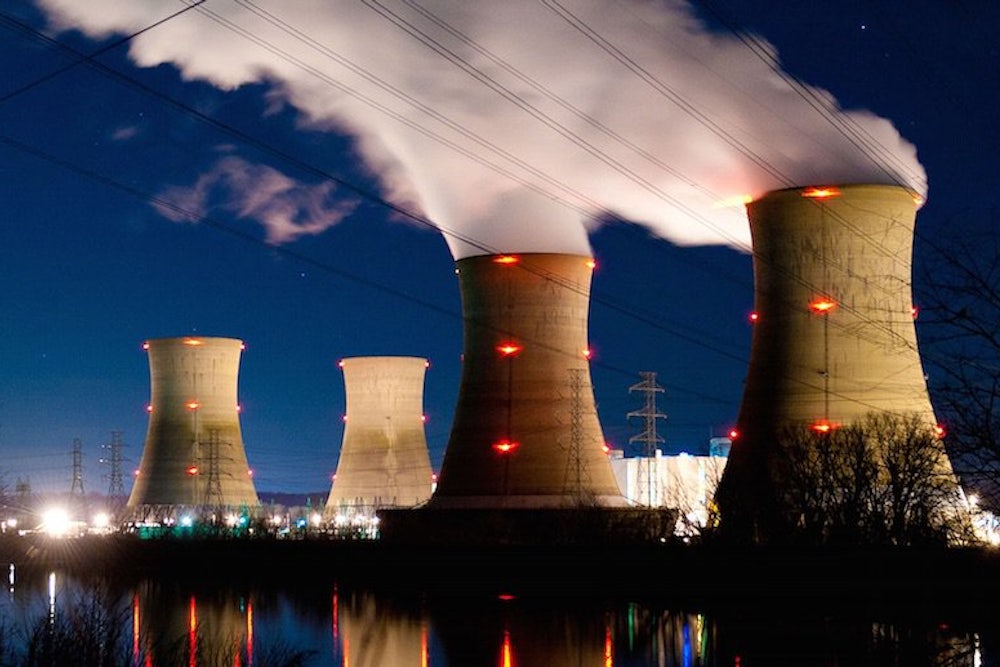President Barack Obama is getting serious about climate change, a challenge that "poses a greater threat to future generations" than any other, he said in last week's State of the Union. In July, his administration announced an EPA regulation to slash carbon pollution from power plants. In November, he struck a pact with China on long-term emission reductions. And recently the White House unveiled a plan to cut methane emissions nearly in half by 2025.
Addressing climate change means, in large part, stepping away from dirty energy sources like coal and oil and toward cleaner sources. That’s a good thing. But it requires developing more energy elsewhere, including from one alternative source that has gotten scant attention in the mainstream press: nuclear energy, which poses its own serious environmental risks.
The EPA’s proposed power-plant regulation provides a carbon credit to states for maintaining nuclear energy production at current levels: in other words, a carbon subsidy for maintaining the nuclear status quo. Following the release of the draft rules, EPA administrator Gina McCarthy made clear that the credit is meant, in part, to help the struggling nuclear industry. “There are a handful of nuclear facilities that, because they are having trouble remaining competitive, they haven’t yet looked at re-licensing,” she said at a roundtable discussion with business leaders in Chicago. If nuclear energy plants begin closing, she warned, “It’s a lot of carbon reduction that needs to be made up for a long period of time.”
Maintaining nuclear power production at current levels isn’t the EPA’s only goal. “Nuclear power is part of an all-of-the-above, diverse energy mix and provides reliable baseload power without contributing to carbon pollution,” the EPA said in a emailed statement. “Nuclear power from current and future plants can help the U.S. meet its goals.”
Nuclear energy also popped-up in the China deal, which promises that the two countries will “continue strengthening their policy dialogue and practical cooperation, including cooperation on advanced coal technologies, nuclear energy, shale gas and renewable energy.”
Why is this worrying? In the fight against climate change, anything is better than dirty coal, right?
For starters, nuclear energy isn’t clean. Although nuclear fission is itself a low-carbon process, the lifecycle carbon cost of nuclear energy production is anything but, with greenhouse gas emissions stemming from uranium mining, milling, processing, enrichment, and transportation, not to mention the years-long—sometimes decades-long—process of actually constructing nuclear reactors. “From our perspective, the longstanding problems with nuclear waste, nuclear nonproliferation [and] safety really set nuclear apart from other low carbon energy sources,” says Matthew McKinzie, director of the Natural Resources Defense Council’s Nuclear Program.
Above everything looms the issue of nuclear waste disposal. There are currently 61 operational nuclear power plants with 99 nuclear reactors in the U.S.—and five more currently under construction—but not a single permanent nuclear waste disposal facility. The proposed Yucca Mountain facility in Nevada has been a political nightmare, and there are currently no front-runners in the search for an alternative site. That is why the Nuclear Regulatory Commission approved a rule last August allowing nuclear energy plants to store nuclear waste on-site (and above ground) indefinitely, essentially easing the environmental review process for new reactors despite the lack of a long-term waste facility.
Some mainstream environmental organizations aren’t concerned. McKinzie called nuclear "a minor player" when it comes to the EPA rules. The Sierra Club is opposed to the nuclear component of the rules, said John Coequyt. But, he added, “The basic deal with nuclear in the United States is that there are a couple of plants that are under construction, and then after that the industry will be on a decline path that is unstoppable at this point.”
Let's hope he's right. But if nuclear energy is so dirty, expensive, and clearly not the future of green energy, then why is the Obama administration actively keeping it alive? Why is it bolstered in the EPA’s rules, and given tribute in the U.S.-China agreement?
Nuclear energy should be left to fend for itself; as cheaper, more efficient energy projects go online, it will struggle to compete. Rather than prop-up a struggling industry, the Obama administration, and whichever administration follows, should eliminate nuclear from its all-of-the-above energy arsenal, relegating it to the category of dirty energies that, if we don't curtail now, will leave future generations cleaning up our environmental mess.
Correction: A previous version of this article referred to the Nuclear Regulatory Commission as the "Nuclear Energy Commission." The agency's rule allowing nuclear energy plants to store nuclear waste on-site was approved in August, not September.
